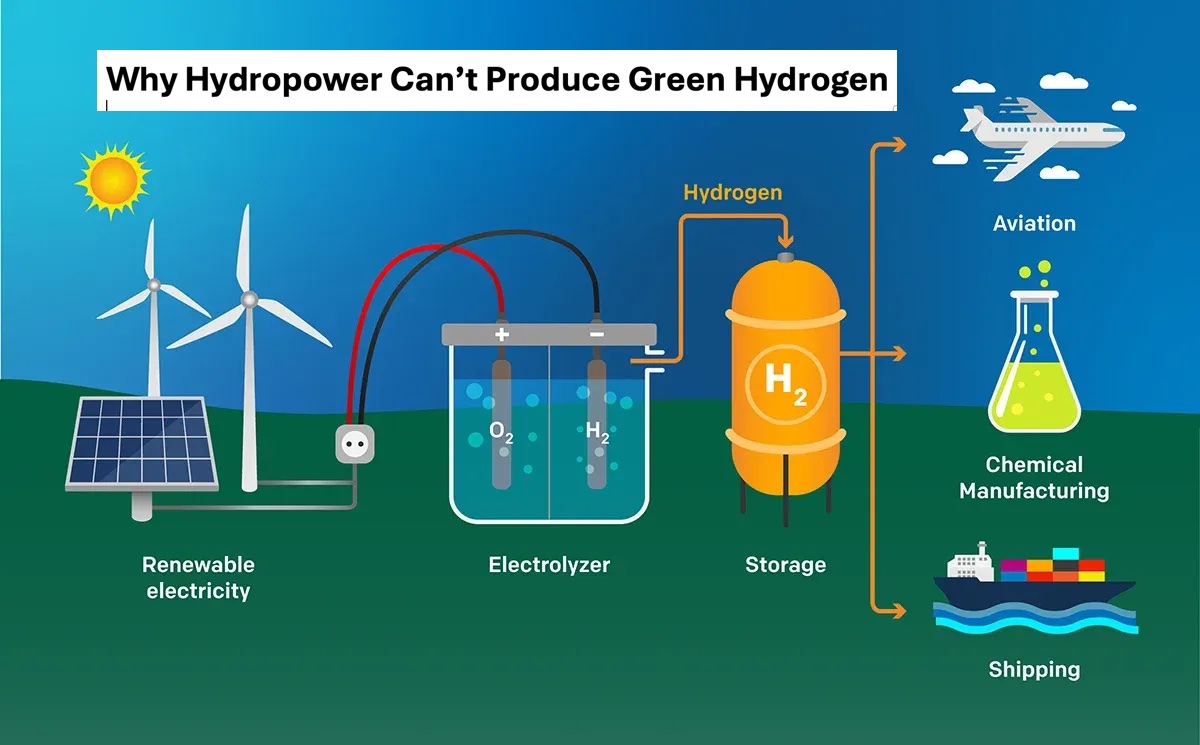According to his own PR, delegates to an Asian Green Energy Conference have been hugely impressed by Abang Jo’s ‘visionary’ plans for creating ‘Green Hydrogen’ and achieving ‘Carbon Capture’.
People who understand science and who do not have a vested interest in dam building or the fossil fuel industry can offer a different perspective that ordinary folk should urgently be made aware of.
Specifically, the use of hydropower (building dams) to create hydrogen is NOT green in the way you might argue using wind or solar power is green, first because it destroys rivers that are vital to our habitat and second because in the process of destroying rivers you pour green house gases into the atmosphere.
This means that before you can start to use any hydrogen created by the energy from a dam you have already created a mass of green house gas emissions that you cannot balance out.
The Sarawak government also apparently hopes, together with the fossil fuel industry advisors who are behind the scheme, that it can lead the world in the dodgy new technology of stuffing carbon back into the holes under the sea that have been created by all the oil and gas extraction of yesteryear.
If this goes wrong which it is bound to), you could face eco-catastrophe on the scale of a nuclear power plant meltdown.
Western scientists might like to suggest Borneo as a good place for that to happen (distant for them) while they experiment on the technology…… Would not nature’s own tried and tested solution be so much more acceptable i.e. the mass re-planting of Borneo’s own natural carbon absorbing trees?
Why should Sarawak be used to belch out gases to create hydrogen for export, so that places such as Tokyo and Seoul can boast about low emissions from their own vehicles without counting the actual cost in terms of destruction and emissions elsewhere?
We all live in the same atmosphere and it’s heating up.
As Save Our World Rivers was plainly not invited to inform the audience at this latest ‘Green Energy’ Conference attended by Abang Jo, we attach their incisive article on the subject which ought to be read by any decision maker in the field and by every voter in Sarawak.
Why Hydropower Can’t Produce Green Hydrogen
[From Save our Rivers – Gary Wockner ]
Over the last two years, I’ve watched “Green Hydrogen” make a splash as the Next Big Thing in the energy field. It was promoted at the U.N.’s COP27, and is currently promoted by NGOs and some of the biggest energy corporations in the world.
First, I’ll give a quick summary of what Green Hydrogen is. Second, I’ll describe why hydropower can never produce it.
What is Green Hydrogen?
Hydrogen is one of the most plentiful elements on Earth and in our atmosphere, and it burns easily and hot. That hydrogen is one of two key elements in all water on the planet (“H2O”), it has great appeal as an abundant energy source. Further, when hydrogen is burned, it only produces water, and doesn’t produce any greenhouse gas emissions (GHG).
As such, although hydrogen has been an energy source for well over 100 years, it has recently gained more attention as a major “low carbon” fuel of the future. Further, because hydrogen burns hot, it is considered a replacement for burning fossil fuels in high-heat industrial and transportation processes that cannot be easily replaced by other forms of renewable energy.
Several methods exist to produce hydrogen including one of the simplest which is “electrolysis” which extracts hydrogen from water, a process that requires electricity. When that electricity is created using renewable energy, and then used to extract and produce hydrogen, that hydrogen is said to be “Green Hydrogen” (read more details simply stated here on Wikipedia).
So-called renewable electricity sources including solar, wind, geothermal, and hydropower* (caveat, see below) are often the main types of electricity discussed that can power electrolysis to produce green hydrogen. When renewable energy sources are used to generate the electricity that extracts hydrogen, the overall GHG footprint of producing and burning hydrogen can decrease dramatically to become a very low-carbon form of energy.
Why Can’t Hydropower Produce Green Hydrogen?
Although all energy sources have an environmentally negative footprint and create some amount of GHGs, I always argue that hydropower has one of the biggest environmentally negative footprints of all energy sources, including fossil fuels.
Almost all forms of hydropower are created by building a dam to block a river and store water in a reservoir that is later run through turbines to create electricity. There are many types of hydropower (briefly discussed later), but every form of hydropower has very negative environmental impacts with dam/reservoir systems being the worst.
First and foremost:
- Dams block rivers including fish migration, sediment movement, debris flow, nutrient flows, and water,
- Dams slow rivers which changes the ecology, water temperature, sediment, and habitat of rivers,
- Dams almost always make water quality worse by hugely changing the hydrological cycle of a river,
- Dams can cause the extinction of fish and aquatic life,
- Dams can make flooding in rivers worse,
- Dams exacerbate coastal flooding, beach erosion, and sea level rise by blocking sediment/debris flow and changing the hydrological cycle of rivers,
- Dams can increase disease in humans due to unnaturally flooded landscapes,
- Dams are hugely expensive and create ‘sunk costs’ scenarios that preclude constructing other less environmentally damaging forms of energy production.
Second and finally, almost all hydropower systems that use dams and reservoirs create greenhouse gas emissions that make climate change worse. Hydropower dams create GHGs in three principal ways:
- Deforestation — across the planet, billions of acres of land have been deforested to make way for dams and reservoirs, including over 6 million acres in one country, Quebec, alone. These forests are often cut and burned in huge waste piles (which emits CO2), and these forests no longer sequester carbon.
- Surface Emissions — when organic material that exists in a reservoir, or flows into a reservoir, decomposes under water, it produces methane. Surface emissions are the biggest source of GHGs in dam/reservoir systems.
- Downstream Dewatering — when wetlands, mangroves, and riparian areas downstream of a dam are dewatered, they dry up and emit CO2 and methane.
Some dam-and-reservoir hydropower facilities produce as much, or more, greenhouse gases as a coal-fired powerplant generating the same amount of electricity (see this presentation posted here, and this short video posted here). Further, various federal agencies in the U.S. — including the EPA — have studied, and are continuing to study, the full extent of GHG emissions that are produced by dams and reservoirs.
Although there are various types of hydropower schemes — including dam/reservoir, run-of-the-river, pumped storage, and others — they all have negative environmental impacts. Further, although large dams are worse than small dams, a sequence of small dams on a river can be just as environmentally harmful as one large dam. Finally, although so-called “closed loop pumped storage” hydropower projects often do have negligible impacts on rivers, they can have huge negative environmental impacts on landscapes, public/private property, and wildlife habitat.
In conclusion, it may make sense to use wind and solar to create electricity to drive electrolysis to produce “green hydrogen” as an alternative energy source. In fact, one presentation at COP27 was titled, “Pathways to a climate-friendly and fair green hydrogen economy”, and provided some promising ideas to achieve those goals. Further, the environmental organization Earthjustice produced an excellent report titled, “Reclaiming Hydrogen for a Renewable Future: Distinguishing Fossil Fuel Industry Spin from Zero-Emission Solutions”, that is worth a read.
However, rivers are “overlooked and undervalued allies in the age of climate crisis”, such that I never see an opportunity for hydropower to produce hydrogen that can ever be called “green”.

